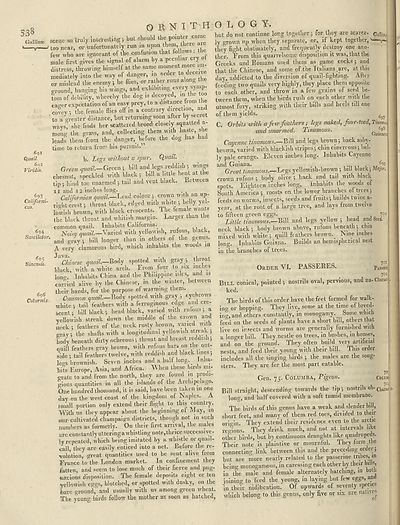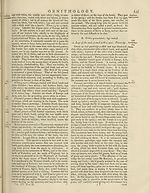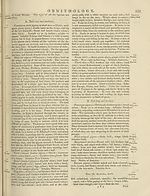Encyclopaedia Britannica > Volume 15, NIC-PAR
(592) Page 538
Download files
Complete book:
Individual page:
Thumbnail gallery: Grid view | List view

538
Gallinse.
^
O R N I T H O LOG Y.
Quail
602
Viridis.
69.I
Califomi-
694
Suscilator.
695
'Sinensis.
6q6
Coturnix.
scene so: truly Interesting •, but should the pointer come
' too near, or unfortunately run in upon them, there arc
few who are ignorant of the contusion that to lows . the
male first gives the signal of alarm by a peculiar ciy o
distress, throwing himself at the same moment more im¬
mediately into the way of danger, in order to deceive
or mislead the enemy ; he flies or rather run, along the
ground, hanging his wings, and exhibiting o'eiy > 1
tom of debility, whereby the dog is decoyed, in the too
eager expectation of an easy prey, to a distance horn th
covey ; the female flies off in a contrary direct ion, and
to a greater distance, but returning soon after by seciet
ways? she finds her scattered brood closely squatted a-
mong the grass, and, collecting them with haste, she
leads them from the danger, before the dog has had
time to return from his pursuit.”
b. Legs without a spur. Quail.
Green rW.-Green ; bill and legs reddish •, wings
chesnut, speckled with black •, bill a little bent at the
tip j hind toe unarmed j tail and vent black. Between
11 and 1 2 inches long. .
Californian quail.—Lead colour ; crown with an up¬
right crest; throat black, edged with white ; belly yel¬
lowish brown, wit!, black crescents. The female wants
the black throat and whitish margin. Larger than the
common quail. Inhabits California. ,
Noisy quail.—Varied with yellowish, rufous, black,
and gray ; bill longer than in others of the genus.
A very clamorous bird, which inhabits the woods in
Chinese quail.—Body spotted with gray •, th. oat
black, with a white arch. From four to six inches
lomr. Inhabits China and the Philippine isles, and is
carried alive by the Chinese, in the winter, between
their hands, for'the purpose of warming them.
Common o?m?7.-*-Body spotted with gray ; eyebrows
white ; tail feathers with a ferruginous edge and cre¬
scent ; bill black; head black, varied with rufous; a
yellowish streak down the middle of the crown and
neck ; feathers of the neck rusty brown, varied with
gray ; the shafts with a longitudinal yellowish streak ;
body beneath dirty ochreous; throat and breast reddish;
quill feathers gray brown, vyith rufous bars on the out¬
side ; tail feathers twelve, with reddish and black lines;
legs brownish. Seven inches and a half long. Inha¬
bits Europe, Asia, and Africa. When these birds mi¬
grate to and from the north, they are found in prodi¬
gious quantities in all the islands ol the Archipelago.
One hundred thousand, it is said, have been taken m one
flay on the west coast of the kingdom of Naples. A
small portion only extend their flight to this country.
With us they appear about the beginning of May, in
our cultivated champaign districts, though not in such
numbers as formerly. On their first arrival, the males
are constantly uttering a whistling noterthiice successive¬
ly repeated, which being imitated by a whistle or quail-
call, they are easily enticed into a net. Before the re¬
volution, great quantities used to be sent alive from
France to the London market. In confinement they
fatten, and seem to lose much of their fierce and pug¬
nacious disposition. The female deposits eight or ten
yellowish eggs, blotched, or spotted with dusky, on the
bare ground, and usually with us among green wheat.
The young birds follow the mother as soon as hatched,
but do not continue long together; for they are scarce. Gallin
ly grown up when they separate, or, if kept together,v-
they fight obstinately, and frequently destroy one ano¬
ther. From this quarrelsome disposition it was, that the
Greeks and Romans used them as game cocks ; and
that the Chinese, and some of the Italians .are, at this
day, addicted to the diversion of quail-fighting. After
feeding two quails very highly, they place them opposite
to each other, and throw in a few grains of seed be¬
tween them, when the birds rush on each other with the
utmost fury, striking with their bills and heels till one
of them yields.
697
C. Orbits with a few feathers ; legs naked, four-toed, Timm, .
and unarmed. Timmons. cJane-
Cayenne tinamous.—Bill anti legs brown; back asby-
brown, varied with blackish stripes; chin cinereous; bel¬
ly pale orange. Eleven inches long. Inhabits Cayenne
and Guiana. , -u 11 1 nr ^95
Great tinamous.—Legs yellowish-brown ; bill black; Major.
crown rufous ; body olive ; back and tail with black
spots. Eighteen inches long,, inhabits the waiods oi
South America ; roosts on the lower branches of trees;
feeds on worms, insects, seeds and fruits; builds twice a-
year, at the root of a large tree, and lays from twelve
to fifteen green eggs. _ , 1 ,1c’00
Little tinamous.—Bill and legs yellow; head and Son.
neck black; body brown above, rufous beneath; chin
mixed with white; quill feathers brown. Nine inches
long. Inhabits Guiana. Builds an hemispherical nest
in the branches ol trees.
Order VI. PASSERES.
7011
Passes:
7°2
Bill conical, pointed ; nostrils oval, pervious, and na-Characj
ked.
The birds of this order have the feet formed for walk¬
ing or hopping. They live, some at the time of breed¬
ing, and others constantly, in monogamy. Some which
feed on the seeds of plants have a short bill, others that
live on insects and worms are generally furnished with
a longer bill. They nestle on trees, in hushes, in houses,
and on the ground. They often build very artificial
nests, and feed their young with their bilk 1 his order
includes all the singing birds ; the males are the song¬
sters. They are for the most part eatable.
Gen. 75. Columba, Pigeon.
n
COLUM
70J
Bill straight, descending towards the tip; nostrils ob-Qara(
long, and half covered with a soft tumid membrane.
The birds of this genus have a weak and slender bill,
short feet, and many of them red toes, divided to their
origin. They extend their residence even to the arctic
regions. They drink much, and not at intervals like
other birds, but by continuous draughts like quadrupeds.
Their note is plaintive or mournful. They form the
connecting link between this and the preceding order;
but are more nearly related to the passerine tribes, m
being monogamous, in caressing each other by their bills,
in the male and female alternately hatching, m both
ioining to feed the young, in laying but few eggs, anti
‘in their nidiheation. Of upwards of seventy species
which belong to this genus, only five or six are natives
Gallinse.
^
O R N I T H O LOG Y.
Quail
602
Viridis.
69.I
Califomi-
694
Suscilator.
695
'Sinensis.
6q6
Coturnix.
scene so: truly Interesting •, but should the pointer come
' too near, or unfortunately run in upon them, there arc
few who are ignorant of the contusion that to lows . the
male first gives the signal of alarm by a peculiar ciy o
distress, throwing himself at the same moment more im¬
mediately into the way of danger, in order to deceive
or mislead the enemy ; he flies or rather run, along the
ground, hanging his wings, and exhibiting o'eiy > 1
tom of debility, whereby the dog is decoyed, in the too
eager expectation of an easy prey, to a distance horn th
covey ; the female flies off in a contrary direct ion, and
to a greater distance, but returning soon after by seciet
ways? she finds her scattered brood closely squatted a-
mong the grass, and, collecting them with haste, she
leads them from the danger, before the dog has had
time to return from his pursuit.”
b. Legs without a spur. Quail.
Green rW.-Green ; bill and legs reddish •, wings
chesnut, speckled with black •, bill a little bent at the
tip j hind toe unarmed j tail and vent black. Between
11 and 1 2 inches long. .
Californian quail.—Lead colour ; crown with an up¬
right crest; throat black, edged with white ; belly yel¬
lowish brown, wit!, black crescents. The female wants
the black throat and whitish margin. Larger than the
common quail. Inhabits California. ,
Noisy quail.—Varied with yellowish, rufous, black,
and gray ; bill longer than in others of the genus.
A very clamorous bird, which inhabits the woods in
Chinese quail.—Body spotted with gray •, th. oat
black, with a white arch. From four to six inches
lomr. Inhabits China and the Philippine isles, and is
carried alive by the Chinese, in the winter, between
their hands, for'the purpose of warming them.
Common o?m?7.-*-Body spotted with gray ; eyebrows
white ; tail feathers with a ferruginous edge and cre¬
scent ; bill black; head black, varied with rufous; a
yellowish streak down the middle of the crown and
neck ; feathers of the neck rusty brown, varied with
gray ; the shafts with a longitudinal yellowish streak ;
body beneath dirty ochreous; throat and breast reddish;
quill feathers gray brown, vyith rufous bars on the out¬
side ; tail feathers twelve, with reddish and black lines;
legs brownish. Seven inches and a half long. Inha¬
bits Europe, Asia, and Africa. When these birds mi¬
grate to and from the north, they are found in prodi¬
gious quantities in all the islands ol the Archipelago.
One hundred thousand, it is said, have been taken m one
flay on the west coast of the kingdom of Naples. A
small portion only extend their flight to this country.
With us they appear about the beginning of May, in
our cultivated champaign districts, though not in such
numbers as formerly. On their first arrival, the males
are constantly uttering a whistling noterthiice successive¬
ly repeated, which being imitated by a whistle or quail-
call, they are easily enticed into a net. Before the re¬
volution, great quantities used to be sent alive from
France to the London market. In confinement they
fatten, and seem to lose much of their fierce and pug¬
nacious disposition. The female deposits eight or ten
yellowish eggs, blotched, or spotted with dusky, on the
bare ground, and usually with us among green wheat.
The young birds follow the mother as soon as hatched,
but do not continue long together; for they are scarce. Gallin
ly grown up when they separate, or, if kept together,v-
they fight obstinately, and frequently destroy one ano¬
ther. From this quarrelsome disposition it was, that the
Greeks and Romans used them as game cocks ; and
that the Chinese, and some of the Italians .are, at this
day, addicted to the diversion of quail-fighting. After
feeding two quails very highly, they place them opposite
to each other, and throw in a few grains of seed be¬
tween them, when the birds rush on each other with the
utmost fury, striking with their bills and heels till one
of them yields.
697
C. Orbits with a few feathers ; legs naked, four-toed, Timm, .
and unarmed. Timmons. cJane-
Cayenne tinamous.—Bill anti legs brown; back asby-
brown, varied with blackish stripes; chin cinereous; bel¬
ly pale orange. Eleven inches long. Inhabits Cayenne
and Guiana. , -u 11 1 nr ^95
Great tinamous.—Legs yellowish-brown ; bill black; Major.
crown rufous ; body olive ; back and tail with black
spots. Eighteen inches long,, inhabits the waiods oi
South America ; roosts on the lower branches of trees;
feeds on worms, insects, seeds and fruits; builds twice a-
year, at the root of a large tree, and lays from twelve
to fifteen green eggs. _ , 1 ,1c’00
Little tinamous.—Bill and legs yellow; head and Son.
neck black; body brown above, rufous beneath; chin
mixed with white; quill feathers brown. Nine inches
long. Inhabits Guiana. Builds an hemispherical nest
in the branches ol trees.
Order VI. PASSERES.
7011
Passes:
7°2
Bill conical, pointed ; nostrils oval, pervious, and na-Characj
ked.
The birds of this order have the feet formed for walk¬
ing or hopping. They live, some at the time of breed¬
ing, and others constantly, in monogamy. Some which
feed on the seeds of plants have a short bill, others that
live on insects and worms are generally furnished with
a longer bill. They nestle on trees, in hushes, in houses,
and on the ground. They often build very artificial
nests, and feed their young with their bilk 1 his order
includes all the singing birds ; the males are the song¬
sters. They are for the most part eatable.
Gen. 75. Columba, Pigeon.
n
COLUM
70J
Bill straight, descending towards the tip; nostrils ob-Qara(
long, and half covered with a soft tumid membrane.
The birds of this genus have a weak and slender bill,
short feet, and many of them red toes, divided to their
origin. They extend their residence even to the arctic
regions. They drink much, and not at intervals like
other birds, but by continuous draughts like quadrupeds.
Their note is plaintive or mournful. They form the
connecting link between this and the preceding order;
but are more nearly related to the passerine tribes, m
being monogamous, in caressing each other by their bills,
in the male and female alternately hatching, m both
ioining to feed the young, in laying but few eggs, anti
‘in their nidiheation. Of upwards of seventy species
which belong to this genus, only five or six are natives
Set display mode to:
![]() Universal Viewer |
Universal Viewer | ![]() Mirador |
Large image | Transcription
Mirador |
Large image | Transcription
Images and transcriptions on this page, including medium image downloads, may be used under the Creative Commons Attribution 4.0 International Licence unless otherwise stated. ![]()
| Encyclopaedia Britannica > Encyclopaedia Britannica > Volume 15, NIC-PAR > (592) Page 538 |
|---|
| Permanent URL | https://digital.nls.uk/192589394 |
|---|
| Attribution and copyright: |
|
|---|
| Shelfmark | EB.11 |
|---|---|
| Description | Ten editions of 'Encyclopaedia Britannica', issued from 1768-1903, in 231 volumes. Originally issued in 100 weekly parts (3 volumes) between 1768 and 1771 by publishers: Colin Macfarquhar and Andrew Bell (Edinburgh); editor: William Smellie: engraver: Andrew Bell. Expanded editions in the 19th century featured more volumes and contributions from leading experts in their fields. Managed and published in Edinburgh up to the 9th edition (25 volumes, from 1875-1889); the 10th edition (1902-1903) re-issued the 9th edition, with 11 supplementary volumes. |
|---|---|
| Additional NLS resources: |
|

